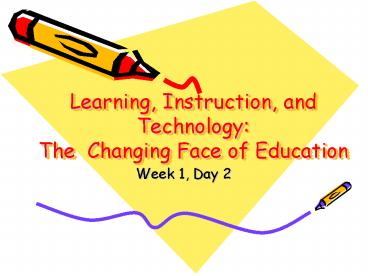Learning, Instruction, and Technology: The Changing Face of Education PowerPoint PPT Presentation
1 / 27
Title: Learning, Instruction, and Technology: The Changing Face of Education
1
Learning, Instruction, and Technology The
Changing Face of Education
- Week 1, Day 2
2
Agenda
- Teach Different Video
- Chapter 1, Learning, Instruction, and Technology
The Changing Face of Education - Entice CD Integrated Learning with Technology
3
Agenda (continued)
- In groups of 4-5, read and discuss Why Can't We
Just Get on with It? article - Using Inspiration software, create a mindmap or
brainstorm of the problems with integrating
technology into teching as well as possible
solutions. - We will save these files as .JPG and post them to
WebCT. For next time, respond to other groups
ideas on the discussion board.
4
Nevada demographics
Source Nevada KIDS COUNT Data Book
2002 http//kidscount.UNLV.edu
5
Children in Poverty
6
School district characteristics
http//kidscount.UNLV.edu/ed-formal_2001.pdf
7
Nevada Dropouts
http//kidscount.UNLV.edu/ed-dropout_2001.pdf
8
(No Transcript)
9
The traditional view of teaching and learning
10
The changing learner
- Problem solving skills
- Real world demands high order reasoning skills to
solve complex problems. - Active learners
- Seeking ways to
- Analyze
- Question
- Interpret
- Understand
11
The changing learner
- Diversity
- Learning styles
- Background experience
- Varied home life settings
12
The shift toward learner centered instruction
- Technology allows individuals to obtain assemble,
analyze, and communicate information in more
detail and at a much faster pace then ever before
possible.
13
Learner Centered Instruction
Learner
Media
14
Role changes for teachers
- A shift from
- Being viewed as the content expert/source for all
answers
- A shift to
- Participating at times as one who may not know it
all by desires to learn
15
Role changes for teachers
- A shift from
- Being viewed as primary source of information who
continually directs it to students.
- A shift to
- Being viewed as support, collaborator, and coach
for students as they learn to gather and evaluate
information for themselves.
16
Role changes for teachers
- A shift from
- Always asking the questions and controlling the
focus of student learning.
- A shift to
- Actively coaching students to develop and pose
their own questions and explore their own
alternative ways of finding answers.
17
Role changes for teachers
- A shift from
- Directing students through preset step-by-step
exercises so that all achieve similar conclusions.
- A shift to
- Actively encouraging individuals to use their
personal knowledge and skills to create unique
solutions to problems.
18
Role changes for students
- A shift from
- Passively waiting for the teacher to give
directions and information
- A shift to
- Actively searching for needed information and
learning experiences, determining what is needed
and seeking ways to attain it.
19
Role changes for students
- A shift from
- Always being in the role of the learner
- A shift to
- Participating at times as the expert/knowledge
provider
20
Role changes for students
- A shift from
- Always following given procedures.
- A shift to
- Desiring to explore, discover and create unique
solutions to learning problems.
21
Role changes for students
- A shift from
- Viewing the teacher as the one who has all the
answers
- A shift to
- Viewing the teacher as a resource, model and
helper who will encourage exploration and
attempts to find unique solutions to problems
22
As teachers views of learners change, how might
this impact their role as instructional experts?
23
- Basic Skills
- The 3 Rs reading, riting and rithmetic are
just as important today as they were in the past.
Research shows that children gain these skills
faster and better when using technology-based
curriculums. Whether just entering the world of
reading and math or preparing for college
entrance, technology can better prepare students
for success. Technology also helps make learning
fun and efficient. That means students will be
more engaged in learning exercises, work for
longer periods of time, and work more on the
things that are not too easy, not too difficult,
but just right for their own level of
accomplishment.
http//www.apple.com/education/k12/curriculumsolut
ions/
24
- Mastering 21st Century Skills
- The skills that people need to master for life
are changing. Students need to learn to read
critically and to speak and write persuasively.
They need to mine the World Wide Web effectively
and efficiently and to understand the meaning
embedded in charts, graphs, audio, video, and
animation. They need to experience new approaches
to learning that are inquiry-based,
collaborative, and perhaps, virtual.
http//www.apple.com/education/k12/curriculumsolut
ions/
25
- Motivating Students to Higher Levels of
Achievement - Studies have shown that when technology is a
routine part of their school experience,
childrens attendance improves and dropout rates
decline. It turns out that the more days students
attend school, the better the chance for success
in their future lives. Research shows that more
children finish high school and many more
consider continuing on to college when they
routinely learn and study with technology.
http//www.apple.com/education/k12/curriculumsolut
ions/
26
- Technology Proficiency
- Basic software tools help even very young
learners become more productive. For example,
third graders find it easier to write with a
keyboard than with a pen. When writing is easier,
children write more when they write more, they
become better writers. Technology proficiency
helps students produce professional looking
documents and helps them take pride in their
work.
http//www.apple.com/education/k12/curriculumsolut
ions/
27
- When we focus on all four areas, achievement
happens.
http//www.apple.com/education/k12/curriculumsolut
ions/

